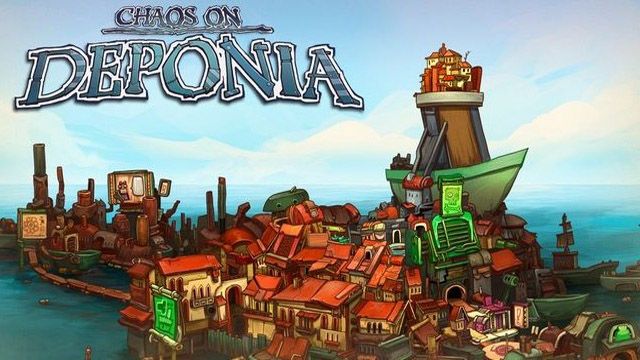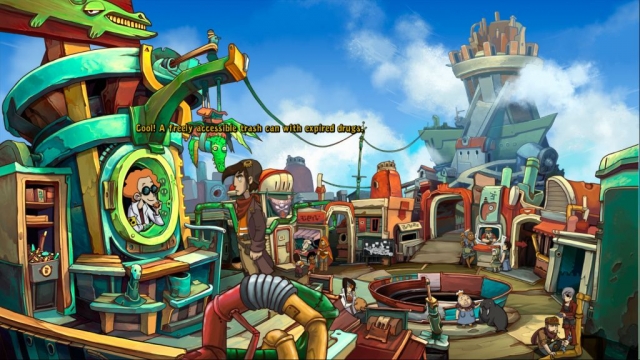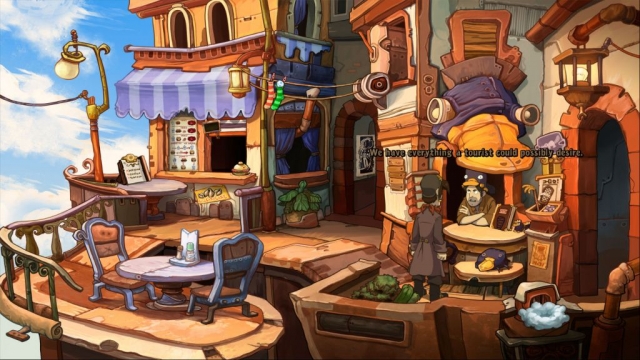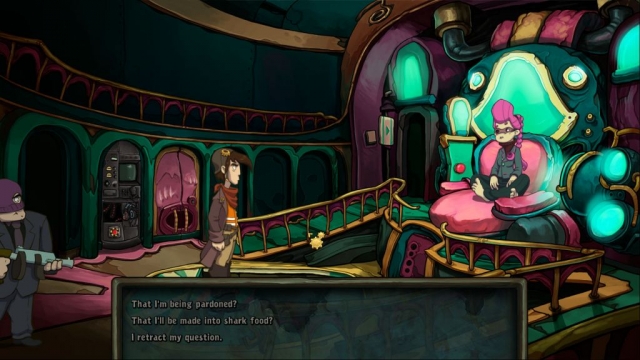Chaos on Deponia Review

Chaos on Deponia is a funny point-and-click adventure from Daedalic Entertainment, and it’s the follow-up to Deponia, which was released a scant four months ago on Steam (and a little longer than that in Europe). Chaos on Deponia picks up right where Deponia left off, with the trash planet Deponia still in danger of being blown up, Goal and her fiancé Cletus on their way to the much cozier world of Elysium, and Rufus abandoned on Deponia. If none of this sounds familiar, or if you didn’t play the original game, then don’t despair. The manual and the game itself review earlier events, and so it’s easy to get caught up with what’s going on.
You control Rufus in the game. He’s a classic anti-hero, who does things to meet his needs without caring too much about how his actions might affect others. To illustrate this point, in the first puzzle sequence in the game Rufus goes about borrowing a hammer while simultaneously burning down someone’s house. It’s not that he wants to burn down the house, but those sorts of things just happen to him. Luckily, since the game is humorous, nobody ever comes to serious harm, even when guillotines become involved (well, except for some baby dolphins who apparently meet a bad end).
Early in the game, Goal ends up back on Deponia, and once again she suffers brain damage, and so once again Rufus has to save her. This time, Goal’s personality is split into three parts, each on a separate cartridge, and Rufus has to convince all three parts that brain surgery (performed by somebody other than Rufus, fortunately) is necessary. This takes up the majority of the game. Afterwards, Rufus once again sets his sights on the Organon, and with the help of a resistance movement, attempts to stop them from blowing up the planet.
Chaos on Deponia uses roughly the same engine as Deponia. You left click to move Rufus around, you left click to talk to people and perform actions on objects, and you right click to examine objects. The mouse wheel is used to open and close the inventory window, and the space bar is used to display hotspots for the room you’re in. This is the same scheme that was used in Deponia, and it’s about the same scheme that is used by every other adventure game out there, making it easy to jump into Chaos on Deponia and start playing.
The puzzles in the game are largely inventory-based, where you pick up objects and then have to figure out how to use them or combine them together to solve problems. These puzzles are a little more difficult than you might expect. That’s because instead of only doling out one or two puzzles at a time, Chaos on Deponia opens things up and gives you a smorgasbord of puzzles at once, with dozens of hotspots and inventory objects in play, making it tougher to trial-and-error your way through them. There are also some mini-games and mechanical puzzles to mix things up, and these are mostly handled pretty well (with only a couple of the mini games being explained poorly).
As an example, at one point you have to take Lady Goal (one of Goal’s three personalities) out to a romantic dinner. But this means you have to convince the local restaurant to serve something other than platypus, which in turn means you have to do something to protect the various platypus nests in the city. You also have to set the mood at the meal by reciting a poem, but since Rufus isn’t any sort of a wordsmith, that means you have to con the local poet into helping you out. As you might have figured out by now, all of the puzzles in the game are on the silly side of the spectrum, involving as they do torpedo dolphins, Unorganized Crime, lisping revolutionaries, and more, and they keep the game entertaining.
The only real downside to the game once again is the dialogue, but not the quality of the writing so much as the quantity. For some reason Daedalic Entertainment just can’t resist using five sentences in places where one sentence would suffice, and so sometimes conversations run on and on without adding anything to the game. This isn’t so bad the first time you hear the dialogue, but when Rufus starts a soliloquy each time you try to use an object on a hotspot, it gets a little tiring, even with being able to skip lines of dialogue by clicking the mouse. Chaos on Deponia isn’t quite as bloated as The Hobbit, but both could have used a better editor.
Chaos on Deponia took me about 15 hours to complete, and that was with only consulting a walkthrough once (to figure out what was going on with one of the mini-games). The puzzles are tough enough that you probably won’t figure them out right away, but they’re not so tough that they’ll stump you for days at a time, either. For me, that’s exactly where I want the difficulty of an adventure to be, and combined with the humor of the game, it makes Chaos on Deponia an easy game to recommend.
Reviewed By: Steven Carter
Publisher: Daedalic Entertainment
Rating: 80%
——————————————————————————–
This review is based on a digital copy of Chaos on Deponia for the PC provided by Daedalic Entertainment.
 Game Over Online
Game Over Online











